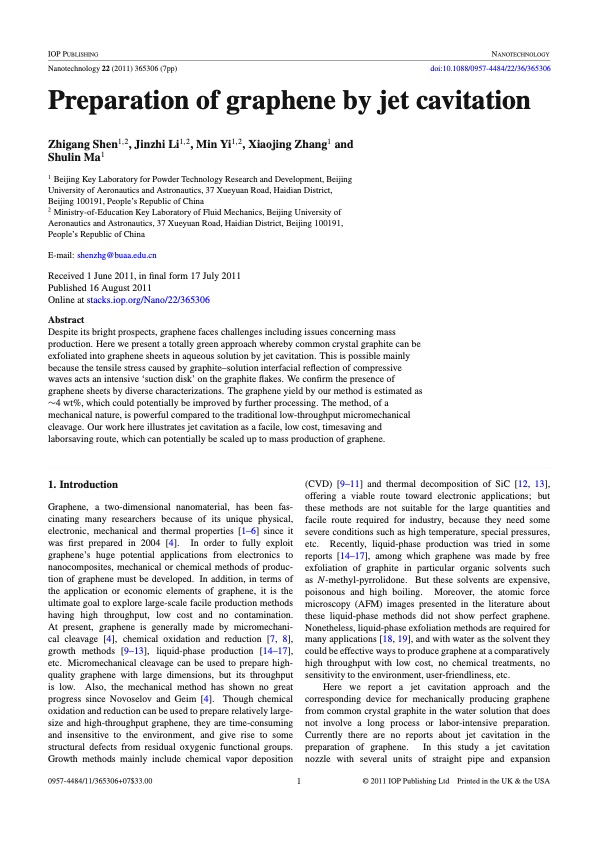
PDF Publication Title:
Text from PDF Page: 002
IOP PUBLISHING NANOTECHNOLOGY Nanotechnology 22 (2011) 365306 (7pp) doi:10.1088/0957-4484/22/36/365306 Preparation of graphene by jet cavitation Zhigang Shen1,2, Jinzhi Li1,2, Min Yi1,2, Xiaojing Zhang1 and Shulin Ma1 1 Beijing Key Laboratory for Powder Technology Research and Development, Beijing University of Aeronautics and Astronautics, 37 Xueyuan Road, Haidian District, Beijing 100191, People’s Republic of China 2 Ministry-of-Education Key Laboratory of Fluid Mechanics, Beijing University of Aeronautics and Astronautics, 37 Xueyuan Road, Haidian District, Beijing 100191, People’s Republic of China E-mail: shenzhg@buaa.edu.cn Received 1 June 2011, in final form 17 July 2011 Published 16 August 2011 Online at stacks.iop.org/Nano/22/365306 Abstract Despite its bright prospects, graphene faces challenges including issues concerning mass production. Here we present a totally green approach whereby common crystal graphite can be exfoliated into graphene sheets in aqueous solution by jet cavitation. This is possible mainly because the tensile stress caused by graphite–solution interfacial reflection of compressive waves acts an intensive ‘suction disk’ on the graphite flakes. We confirm the presence of graphene sheets by diverse characterizations. The graphene yield by our method is estimated as ∼4 wt%, which could potentially be improved by further processing. The method, of a mechanical nature, is powerful compared to the traditional low-throughput micromechanical cleavage. Our work here illustrates jet cavitation as a facile, low cost, timesaving and laborsaving route, which can potentially be scaled up to mass production of graphene. 1. Introduction Graphene, a two-dimensional nanomaterial, has been fas- cinating many researchers because of its unique physical, electronic, mechanical and thermal properties [1–6] since it was first prepared in 2004 [4]. In order to fully exploit graphene’s huge potential applications from electronics to nanocomposites, mechanical or chemical methods of produc- tion of graphene must be developed. In addition, in terms of the application or economic elements of graphene, it is the ultimate goal to explore large-scale facile production methods having high throughput, low cost and no contamination. At present, graphene is generally made by micromechani- cal cleavage [4], chemical oxidation and reduction [7, 8], growth methods [9–13], liquid-phase production [14–17], etc. Micromechanical cleavage can be used to prepare high- quality graphene with large dimensions, but its throughput is low. Also, the mechanical method has shown no great progress since Novoselov and Geim [4]. Though chemical oxidation and reduction can be used to prepare relatively large- size and high-throughput graphene, they are time-consuming and insensitive to the environment, and give rise to some structural defects from residual oxygenic functional groups. Growth methods mainly include chemical vapor deposition (CVD) [9–11] and thermal decomposition of SiC [12, 13], offering a viable route toward electronic applications; but these methods are not suitable for the large quantities and facile route required for industry, because they need some severe conditions such as high temperature, special pressures, etc. Recently, liquid-phase production was tried in some reports [14–17], among which graphene was made by free exfoliation of graphite in particular organic solvents such as N-methyl-pyrrolidone. But these solvents are expensive, poisonous and high boiling. Moreover, the atomic force microscopy (AFM) images presented in the literature about these liquid-phase methods did not show perfect graphene. Nonetheless, liquid-phase exfoliation methods are required for many applications [18, 19], and with water as the solvent they could be effective ways to produce graphene at a comparatively high throughput with low cost, no chemical treatments, no sensitivity to the environment, user-friendliness, etc. Here we report a jet cavitation approach and the corresponding device for mechanically producing graphene from common crystal graphite in the water solution that does not involve a long process or labor-intensive preparation. Currently there are no reports about jet cavitation in the preparation of graphene. In this study a jet cavitation nozzle with several units of straight pipe and expansion 0957-4484/11/365306+07$33.00 1 © 2011 IOP Publishing Ltd Printed in the UK & the USAPDF Image | Preparation of graphene by jet cavitation

PDF Search Title:
Preparation of graphene by jet cavitationOriginal File Name Searched:
graphene-by-jet-cavitation.pdfDIY PDF Search: Google It | Yahoo | Bing
Salgenx Redox Flow Battery Technology: Power up your energy storage game with Salgenx Salt Water Battery. With its advanced technology, the flow battery provides reliable, scalable, and sustainable energy storage for utility-scale projects. Upgrade to a Salgenx flow battery today and take control of your energy future.
| CONTACT TEL: 608-238-6001 Email: greg@infinityturbine.com | RSS | AMP |